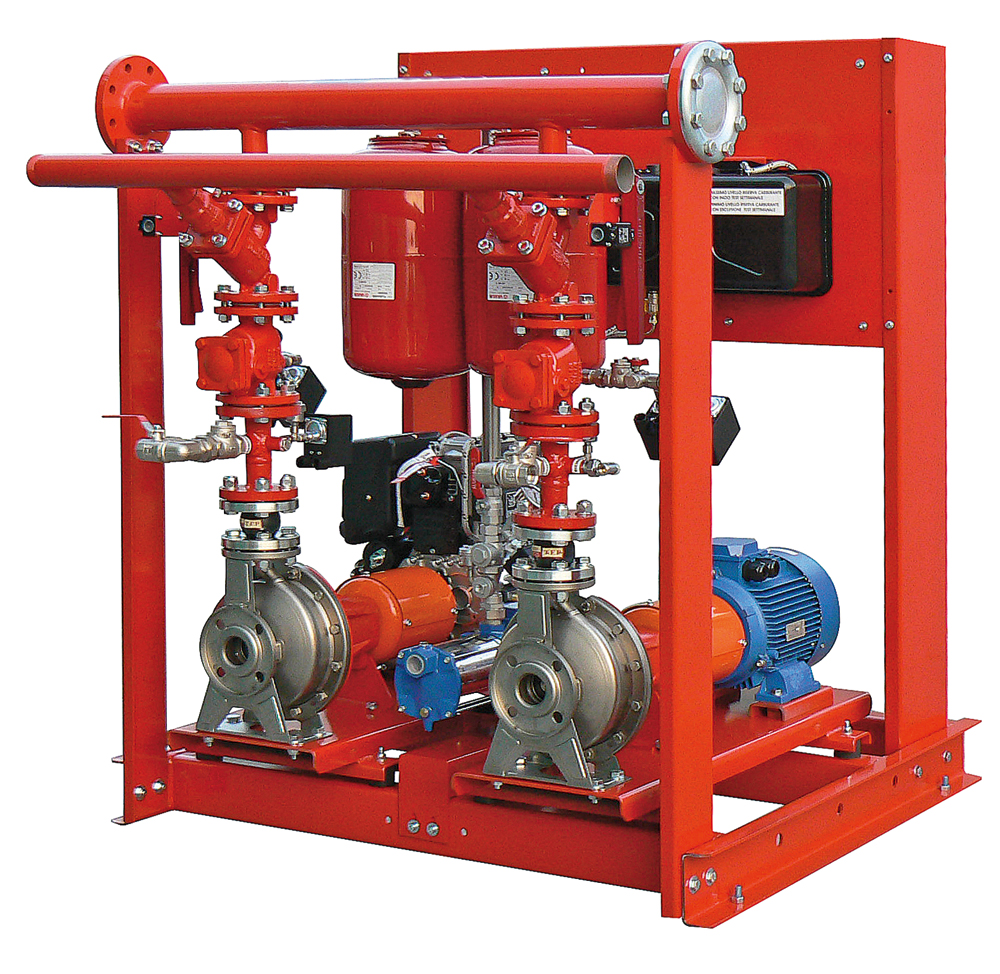 Description and Applications
Description and Applications
The feed water fire extinguishing systems in the service of water can be achieved by public water systems or groups of private feed.
The fire protection water supplies served by public water systems are reliable and provide continuity of water supply but usually have performance in terms of flow and pressure very limited.
The private fire protection water supplies are built to measure the plant shutdown to which they are enslaved, but their level of reliability is often low due to the low maintenance and consideration that is paid over time in this type of system.
The private fire protection water supplies are mainly of three types:
- elevated water tanks
- Tanks Water Pressure
- tanks with water pumping systems.
The pumping unit reservoirs or high gravity, provided by the reference standard UNI 9490, are becoming less frequent because of the high cost of implementation. E ‘undoubted reliability; fact it requires no thrust for the water that reaches a result of the piezometric column with pressures of the order of 4 – 5 Bar and therefore is free from interruption of electric supply to black out or for failure to start the pumps of internal combustion engines.
For this type of systems of power are required the usual accessories such systems:
- system restoration at the 1 lpm for every cubic meter of capacity
- a nozzle ventilation
- a level indicator visible from the ground and an optical signal noise back to a place unattended;
- an overflow system.
The reservoirs pressure use for their operation the principle of the autoclave, in which practically an air cushion provides the momentum necessary to ensure the outflow of water from the reservoir. This water supply system but these are not turns out to be an optimal solution for a system that has a water demand remarkable since the high pressure needed to ensure the performance of operation would involve the adoption of sheet metal tanks designed to withstand pressures above 8 Bar of the purchase price and very high maintenance.
The reservoir pressure is therefore valid for the power supply of plants of small or medium-sized and for the protection of light hazard.
The water supply system is the most common system consists of a storage tank (reserve) and a pumping system to start up automatically. The water supply system with storage tanks and pumping station is presented of great functionality and reliability and can be divided into two types according to the type of water reserve used:
- water reserves in underground storage tanks;
- water supply in tanks or storage tanks above ground
The choice of the underground storage tank is usually required for reasons of space or architectural or environmental impact. The underground storage tank is made of reinforced concrete and cast in situ. In the case of a loss of sealing the water caused by the normal aging of the structure or by a failure to preventive maintenance is possible to recover the functionality with the application of special sheaths PVC or HDPE cost of very limited.
The cover even if not required by the standard and always recommended to minimize the considerable problems of cleaning, algae and safety and may choose the “pool ” does not solve the problem of space footprint that is as already ; mentioned, the main reason for the choice inground.
The covers can be made in various ways but the solution of the driveway is the best and most frequently. Even for this type of power plant systems are required the usual accessories such as:
- system restoration at the 1 lpm for every cubic meter of capacity
- two access hatches, on opposite sides, to allow a good ventilation in the event of maintenance operations inside the tank;
- a visible level indicator and an optical signal noise back to a place unattended;
- an overflow system.
In case of realization of a water reservoir above ground solutions are manifold.
The best and most frequently for its reduced cost is the adoption of galvanized metal tanks of cylindrical shape. The main problems of the tank above ground are linked over architectural impact, to the realization of a network connection to the pumps of the pumping unit and the construction of a local used for accommodating the pumps. Another not insignificant aspect is that relating to the mechanical strength of the soil where the audience must be made of concrete for placement of the reservoir.
In case of realization of a concrete tank above ground it is possible to use prefabricated components which, in addition inexpensiveness, allows a great simplicity of realization. The accessory systems are similar to those adopted for the other types.
Essential component for the operation of power systems in the storage tank is the pump station.
The pumping station must find a place in a local totally independent and resistant to fire for 120 minutes, with access from the outside; in the case of a plant hydrant the norm UNI 10779 provides for the possibility of placing the pump station in a local common to other water systems provided they are not exposed to significant risk of fire. Alternative to the construction of the local fire resistance is the construction of a building block that can also consist of lightweight structures (structure in panels, containers) provided that they retain the characteristics of combustibility.
The pumping station can be made with one of the following formats:
- pump room coplanar with the water supply, both above ground
- pump room coplanar with the water supply, both underground
- pump room superimposed on the water reservoir.
The solution of the pump room coplanar with the water supply, both above ground is the best technical solution and more convenient from the economic point of view, it is not subject to flooding caused by leaks in pipes and is easily insurable adequate ventilation. In addition there is the advantage, just for the complanarietá, to be able to install ordinary centrifugal pumps, operating under the head.
In the solution of the pump room coplanar with the water supply, both underground must all be resolved a number of issues that complicate the simplicity and reliability of operation. These complications are, the risk of flooding by losses from the piping and its overflow, the difficulty of access and exit, in case of emergency and the realization of an adequate ventilation system.
The solution of the pump room superimposed on the water reservoir is a functional solution as long as you take vertical pumps, impellers immersed and outboard motor. The UNI 9490 permit both the installation of pumps submersible monobloc type, with submerged motor and the installation of horizontal pumps suction vacuum (not in the door) with a special system priming.
To choose the type of pump to be considered the following functional characteristics to the water demand of the fire extinguishing system:
- the nominal capacity, with an escort of about 20 – 30%
- the nominal pressure, slightly higher than the required pressure (15 – 20%) for the operation of the plant, so as to avoid the effect of excessive demand arising from the actual operation
- the characteristics of the spare pump.
The ideal solution is that of a single group dimensioned for the entire water demand and reserve with the same size so as to obtain a reserve 100% of rated capacity.
In the selection of pumps and also a good idea to define the following requirements:
il rispetto dell’NSPH tipica della pompa adottata
la velocitá di rotazione che dovrebbe essere del 15 – 20% inferiore alla velocitá massima raggiungibile, al fine
- respect dell’NSPH typical pump adopted;
- the speed of rotation that should be 15 – 20% lower than the maximum speed reachable, in order can count on a possible increase in power
- the characteristics of the electric control panel and start-up and its individual components;
- the availability of spare parts to minimize downtime operation of the fire off.
Regarding the choice between electric or diesel pump units is straightforward to indicate the first as the best solution. The electric pump is certainly more reliable THE UNIT diesel both from the point of view of simplicity of goodwill, both from the point of view of continuity of the power delivery.
The choice of the diesel pump is preferable when the power requirements exceed the hundred kilowatts and the distance between the substation and the pump room is more than 100 meters.
In the installation of an electric pump is advisable to check the classic protections load, which are instead typical of the use of industrial engines, and which are designed to prevent the failure of equipment, protecting them precisely against overloads, but which can have important exclusions power supply is not appropriate for a sprinkler system.
Rarely pumping systems that use electrical units are coupled by diesel generators, as a function of emergency power supply. This solution in fact the sum of uncertainties start of the pumping unit, with those typical of the group of diesel generation. Viable alternative for pumping of limited size can be the use of groups of continuity that can guarantee the power up to a few tens of kilowatts.


